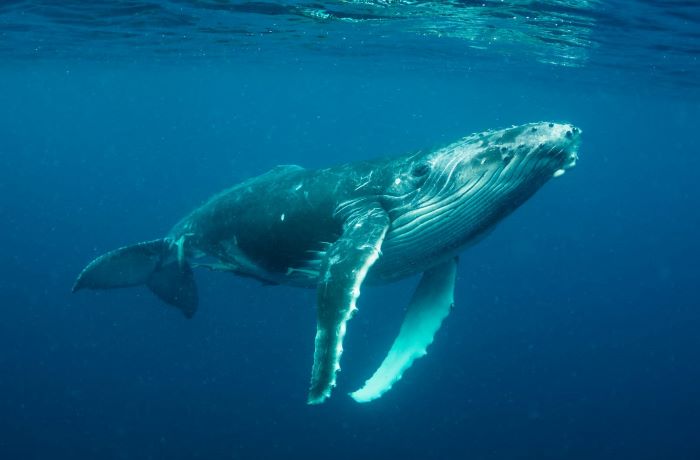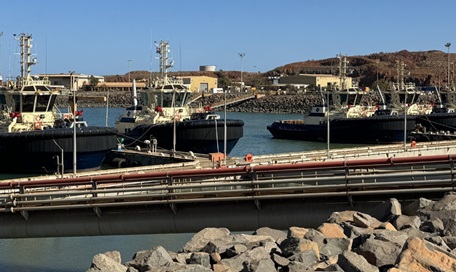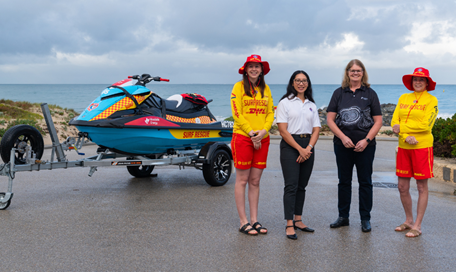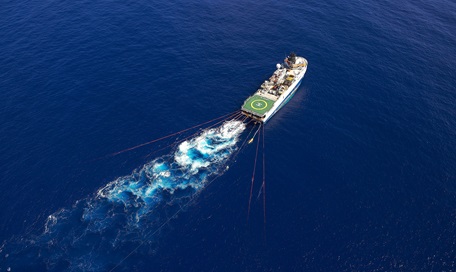Whales and Woodside
For decades, Woodside has had a robust approach to identifying and managing potential environmental impacts and risks associated with our offshore activities.
Advancing Whale Research in Australia
For more than 30 years, we have invested in funding research into whale seasonality, distribution, and abundance in Western Australian waters. Our total investment in whale research, alongside our joint venture partners, is approximately A$30 million, making Woodside one of the largest funders of whale research in Australia.



More recently, our research into the pygmy blue whale was recognised at the annual Australian Petroleum Production and Exploration Association Conference where Woodside received the Environment Project Excellence Award for “scientific innovation and collaboration enabling effective management of pygmy blue whales in Australia’s northwest”.
30 Years of Humpback Whale Knowledge
The Western Australian humpback whale population migrates up and down the WA coast every year, travelling from feeding grounds in Antarctic waters to their calving habitat in WA’s warm tropical waters.
The WA coast is a hot spot for whale watchers, particularly off the Ningaloo Coast.
These fantastic creatures cover vast distances yearly and have one of the longest migrations of any mammal on earth. In the eastern Indian Ocean, Humpback whales migrate from Antarctica to the Kimberley (in northern Western Australia), covering over 5,000 kilometres1 in as few as 28 days – that is like swimming from Perth to Adelaide and back in less than a month.
In collaboration with the Australian Institute of Marine Science and Western Australian Museum, Woodside celebrates over 20 years of scientific partnership and research.
Source: Voyages of Science, Woodside, 2018
The WA coast is one of 14 distinct population segments1 , along with the West Indies, Hawaii, Brazil and Eastern Australia, to name a few. Unfortunately, during the 1970s, the estimated humpback whale population in WA fell sharply to around 800 due to commercial whaling. Since then, WA humpback whale population numbers have recovered dramatically to more than an estimated 30,000 in 2021. Humpback whales have now been removed from the Australian Environment Protection and Biodiversity Conservation (EPBC) Act threatened species list as a result of full population recovery.
Woodside is committed to applying a continuous improvement approach in how we manage our offshore activities. We also uphold all relevant environmental management standards to ensure the health of the humpback whale population.
Moving Forward: The Future of Pygmy Blue Whale Research
We are now applying the same science-based mitigation and management approach to pygmy blue whales. Woodside has been supporting pygmy blue whale research since the early 2000s, through partnerships with the Australian Institute of Marine Science (AIMS), the Australian Antarctic Division and the Centre for Whale Research (CWR).
AIMS is Australia’s tropical marine research agency renowned for its global science excellence, the Australian Antarctic Division (AAD) deliver the Australian Antarctic Program to support Australia’s science and permanent presence in Antarctica and the CWR (Western Australia) Inc. is a non-profit research institute established to conduct scientific research into marine mammals.
Source: Pygmy Blue Whale Research: An Appetite For Data, AIMS, 2023
Woodside’s partnership seeks to understand the movement and behaviours of pygmy blue whales in Australia’s northwest through research. Using the latest satellite tracking technology and this data has been a vital input into modelling the likely response of pygmy blue whales to underwater noise emissions. This will inform the management of Woodside’s offshore activities to avoid or minimise potential impacts and contributes to broader industry knowledge around habitat management and conservation efforts. Learn more about our pygmy blue whale research in our 2022 Sustainable Development Report.
Overall, we remain committed to supporting the collection of credible whale science through our research and to support the long-term management of whale populations in the regions where we operate.
Resources:
Find out more about Woodside’s environment and biodiversity approach: Environment and Biodiversity - Woodside Energy
Read the 2022 Sustainability Development report: sustainable-development-report.pdf (woodside.com)
AIMS: https://www.aims.gov.au
Centre for Whale Research WA: https://www.cwr.org.au
Scientific papers resulting from Woodside funded research:
Humpback Whales:
- Cato, D.H., Noad, M.J., Dunlop, R.A., McCauley, R.D., Gales, N.J., Salgado Kent, C.P., Kniest, H., Paton, D., Jenner, K.C.S., Noad, J., Maggi, A.L., Parnum I.M., Duncan, A.J. (2013). A study of the behavioural response of whales to the noise of seismic air guns: design, methods and progress. Acoustics Australia, 41, 91-100.
- Cato, D., Noad, M., Dunlop, R., McCauley, R., Gales, N., Salgado-Kent, C., ... & Duncan, A. (2012). Project BRAHSS: behavioural response of Australian humpback whales to seismic surveys. Proceedings of the Acoustical Society of Australia.
- Dunlop, R. A., McCauley, R. D., & Noad, M. J. (2020). Ships and air guns reduce social interactions in humpback whales at greater ranges than other behavioral impacts. Marine Pollution Bulletin, 154, 111072.
- Dunlop, R. A., Noad, M. J., McCauley, R. D., Kniest, E., Slade, R., Paton, D., & Cato, D. H. (2018). A behavioural dose-response model for migrating humpback whales and seismic air gun noise. Marine pollution bulletin, 133, 506-516.
- Dunlop, R. A., Noad, M. J., McCauley, R. D., Kniest, E., Slade, R., Paton, D., & Cato, D. H. (2017). The behavioural response of migrating humpback whales to a full seismic airgun array. Proceedings of the Royal Society B: Biological Sciences, 284(1869), 20171901.
- Dunlop, R.A., Noad, M.J., McCauley, R.D., L. Scott-Hayward, Kniest, E., Slade, R. Paton, D., and Cato, D.H. (2017). Determining the behavioural dose-response relationship of marine mammals to air gun noise and source proximity. Journal of Experimental Biology, 220, 2878-2886, doi:10.1242/jeb.160192.
- Dunlop, R. A., Noad, M. J., McCauley, R. D., Kniest, E., Slade, R., Paton, D., & Cato, D. H. (2016). Response of humpback whales (Megaptera novaeangliae) to ramp-up of a small experimental air gun array. Marine pollution bulletin, 103(1-2), 72-83.
- Dunlop, R. A., Noad, M. J., McCauley, R. D., Kniest, E., Paton, D., & Cato, D. H. (2015). The behavioural response of humpback whales (Megaptera novaeangliae) to a 20 cubic inch air gun. Aquatic Mammals, 41(4), 412.
- Dunlop, R. A., Noad, M. J., Cato, D. H., Kniest, E., Miller, P. J., Smith, J. N., & Stokes, M. D. (2013). Multivariate analysis of behavioural response experiments in humpback whales (Megaptera novaeangliae). Journal of Experimental Biology, 216(5), 759-770.
- Dunlop, R.A., Noad, M.J., Cato, D.H. (2012). Behavioural-response studies: problems with statistical power. In Effects of Noise on Aquatic Life, ed. Popper A.N. and Hawkins, A. Springer, New York, 293-297.
- Gales, N., Double, M. C., Robinson, S., Jenner, C., Jenner, M., King, E., ... & Paton, D. (2010). Satellite tracking of Australian humpback (Megaptera novaeangliae) and pygmy blue whales (Balaenoptera musculus brevicauda). White paper presented to the Scientific Committee of the International Whaling Commission.
- Godwin, E.M., Noad, M.J., Kniest, E., and Dunlop, R.A. (2016). Comparing multiple sampling platforms for measuring the behavior of humpback whales (Megaptera novaeangliae). Marine Mammal Science, 32, 268-286.
- Jenner, K. C., Jenner, M. M., & McCabe, K. A. (2001). Geographical and temporal movements of humpback whales in Western Australian waters. The APPEA Journal, 41(1), 749-765.
- Kavanagh, A. S., Owen, K., Williamson, M. J., Blomberg, S. P., Noad, M. J., Goldizen, A. W., ... & Dunlop, R. A. (2017). Evidence for the functions of surface‐active behaviors in humpback whales (Megaptera novaeangliae). Marine Mammal Science, 33(1), 313-334.
- Kavanagh, A.S., Goldizen, A.W., Blomberg, S.P., Noad, M.J. and Dunlop R.A. (2016). Factors Affecting the Reliability and Validity of Behavioural Datasets: Assessing the Impact of Observers’ Experience and Native Language on Studies of Wild Animals. Aquatic Mammals, 42, 1-11.
- Salgado Kent, C., Jenner, C., Jenner, M., Bouchet, P., & Rexstad, E. (2012). Southern Hemisphere breeding stock 'D' humpback whale population estimates from North West Cape, Western Australia. Journal of Cetacean Research and Management, 12(1), 29-38.
- Thums, M., Jenner, C., Udyawer, V., Ferreira, L., Waples, K., Jenner, M., & Meekan, M. (2018). Modelling the movement and spatial distribution of humpback whales in the nearshore waters of the Kimberley. Humpback whale use of the Kimberley; understanding and monitoring spatial distribution, 1(1), 1.
- Thums, M., Jenner, C., Waples, K., Salgado Kent, C., & Meekan, M. (2018). Humpback whale use of the Kimberley; understanding and monitoring spatial distribution. Report of Project, 1(1).
- Williamson, M. J., Kavanagh, A. S., Noad, M. J., Kniest, E., & Dunlop, R. A. (2016). The effect of close approaches for tagging activities by small research vessels on the behavior of humpback whales (Megaptera novaeangliae). Marine Mammal Science, 32(4), 1234-1253.
Pygmy Blue Whales:
- Double, M.C., V. Andrews-Goff, C. Jenner, M. Jenner, S.M. Laverick, T. A. Branch and N.J. Gales (2014). Migratory movements of pygmy blue whales (Balaenoptera musculus brevicauda) between Australia and Indonesia as revealed by satellite telemetry. PLOS ONE 9 (4):e935778.
- Gales, N., M.C., Double, S. Robinson, C. Jenner, M. Jenner, E. King, J. Gedamke, S. Childerhouse and D. Paton (2010). Satellite tracking of Australian humpback (Megaptera novaeangliae) and pygmy blue whales (Balaenoptera musculus brevicauda). SC/62/SH21 International Whaling Commission (IWC) paper.
- McCauley, R.D. and Jenner, C. (2010). Migratory patterns and estimated population size of pygmy blue whales (Balaenoptera musculus brevicauda) traversing the Western Australian coast based on passive acoustics. Paper SC/62/SH26 presented to the IWC Scientific Committee, June 2010, Agadir, Morocco (unpublished). 9pp. [Paper available from the Office of the IWC].
- Sutton, A.L., C. Jenner and M. Jenner (2019). Habitat associations of cetaceans and seabirds in the tropical eastern Indian Ocean. Deep-Sea Research Part II 166:171-186.
- Thums, M., L. Ferreira, C. Jenner, M Jenner, D Harris, A Davenport, V Andrews-Goff, M. Double, L. Moller, C. R. M. Attard, K. Bilgmann, P. Thomson and R. McCauley (2022). Quantifying movement and distribution of pygmy blue whales in the Eastern Indian Ocean. Global Ecology and Conservation 35: e02054.
1 https://www.fisheries.noaa.gov/species/humpback-whale



